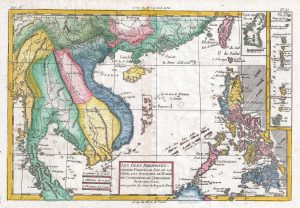Most Europeans came to Southeast Asia to trade, some came to proselytize and, eventually, some came to rule. But, from the outset, Portuguese, Spanish, Dutch, and English arrivals were obliged to compete or cooperate with established states, ranging in size from empires like Majapahit or Ming China to tiny principalities.
It was only in the late 19th century that Europeans came to dominate. The century between 1862, when the French Navy captured Saigon, and 1956, when France departed the newly independent state of Vietnam, was the era of “high colonialism,” but Europeans were present in the region from the Portuguese capture of Melaka in 1511 until the British departure from Hong Kong in 1997.
Throughout this period, the South China Sea was primarily important as a route through which the spices and porcelains that Asians supplied, and Europeans demanded, were transported. Traders were only concerned about the sea’s islands, rocks, and reefs to the extent that they were hazards to shipping, havens for pirates, or harbors for adversaries. European control was limited to a few entrepots around the coasts, including Melaka, Macau (1557), Cebu (1564), Manila (1571), Bantam (1603), Batavia/Jakarta (1619), Formosa/Taiwan (1624), Penang (1786), and Singapore (1819).
After Manchu invaders conquered Ming China and established the Qing dynasty, they imposed restrictions on maritime trade. Once they were lifted, in 1683, Chinese merchants benefited at least as much as those from Europe, Southeast Asia, South Asia, or the Middle East. As Léonard Blussé has demonstrated, the 18th century became the “Chinese century” in South China Sea trade. The historian Wang Gungwu has called these traders “merchants without empire.” They traded for themselves, without the protection of their state, but still outcompeted their rivals. As a result, the Dutch began to withdraw from direct involvement in the China trade after the 1680s and ceded the dominant European role to the British.
The British-owned East India Company first mapped the Paracel Islands in the 1800s. Some of the islands are still named after its managers: Pattle, Roberts, Drummond, Duncan, and Money. (The Chinese name for Money Island, Jin Yin Dao, is just a translation of this imperialist’s name.) Arguments over whether to build lighthouses on the islands lasted for a century. Everyone agreed that something should be done to stem the toll of shipwrecks and lost lives, but no one wanted to pay for them. This lack of interest in the islands, from all sides, was the major feature of the entire period.
































